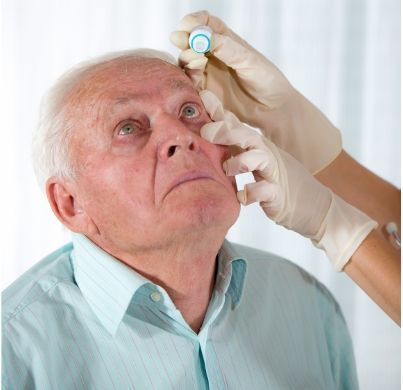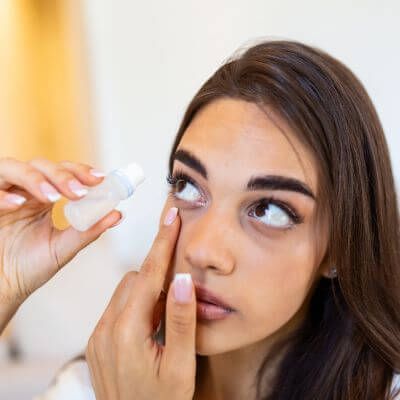3 Best Treatments for Glaucoma
Glaucoma is often referred to as the “silent thief of sight,” and for good reason. It slowly damages your optic nerve over time without any symptoms in the early stages before vision loss becomes apparent. There is no cure for glaucoma, which is why early detection and treatment should be your top priority.

Eye drops are often the first step in glaucoma treatment. There are many different kinds that fight glaucoma in different ways. If eye drops aren’t enough, then your doctor may recommend oral medication to help bolster the fight against glaucoma. You may need surgery if you have advanced glaucoma or can’t use eye drops or oral medication.
1. Eye Drops for Glaucoma
When it comes to treating glaucoma , eye drops will usually be your doctor’s first choice. The goal of any glaucoma treatment is to lower the pressure in your eye, and these special eye drops excel at that task. When applied directly to your eye, they can either:
- Improve how fluid drains from your eye
- Reduce how much fluid your eye produces
Eye drops used for glaucoma treatment aren’t like the kind you buy off the shelf at your local drug store. Your ophthalmologist will provide you with a prescription for the type of eye drops they think will best serve your needs. A few of the most frequently prescribed are listed below.
Prostaglandins
Prostaglandins lower your eye pressure by increasing the amount of fluid that leaves your eye. Common prostaglandin eye drops for glaucoma include:
- Xalatan ( Latanoprost )
- Vyzulta ( Latanoprostene Bunod )
- Zioptan ( Tafluprost )
- Travatan Z ( Travoprost )
- Lumigan ( Bimatoprost )
Prostaglandins are a once-daily eye drop, which is ideal if you have a hectic schedule. Side-effects may include blurred vision, darkened pigments of eyelids or eyelashes, mild reddening of the eyes and/or eyelids, and darkening of the iris.
Beta-Blockers
Beta-blockers reduce eye pressure by lowering the amount of fluid that’s produced. Common beta-blockers include Betimold, Istalol, and Timoptic, which are all forms of timolol. Betopic ( betaxolol ) is another popular choice.
You can get a prescription for once- or twice-daily drops depending on the severity of your condition. Side effects may include trouble breathing, low blood pressure, low heart rate, fatigue, and impotence.
Alpha-Adrenergic Agonists
Alpha-adrenergic agonists lower the production of aqueous humor , which is the clear liquid that fills the space between the lens and cornea at the front of your eye. This strengthens the flow of eye fluid as it’s leaving the eye. Popular forms of alpha-adrenergic agonists are Alphagan P and Qoliana from brimonidine and Apraclonidine from iopidine.
Alpha-adrenergic agonists are usually twice-a-day drops. However, they can be prescribed for three times per day if your situation warrants it. Side effects may include dry mouth, irregular heartbeat, fatigue, high blood pressure, and irritated or swollen eyes.
Carbonic Anhydrase Inhibitors
Carbonic anhydrase inhibitors work to reduce your eye’s fluid production. Examples include Trusopt ( dorzolamide ) and Azopt ( brinzolamide ). Like alpha-adrenergic agonists, they’re usually prescribed for once-daily use but may be increased to three. With this type of eye drop, you may experience increased urination, tingling in your fingers and toes, or a metallic taste.
Rho Kinase Inhibitors
Rho kinase inhibitors work a bit differently from the other eye drops we’ve mentioned so far. They are able to lower eye pressure by increasing outflow from the eye.
Rho kinase inhibitors come in the form of Rhopressa ( netarsudil ) and are once-a-day drops. Side effects may include eye discomfort, red eyes, and deposits developing on the cornea.
2. Oral Medication That Treats Glaucoma
Sometimes eye drops aren’t enough to treat your glaucoma symptoms. In cases like these, your doctor may recommend oral medications to help keep your symptoms in check. Most oral glaucoma medications are carbonic anhydrase inhibitors . You may experience upset stomach, fatigue, and memory problems with these pills.
It’s important to remember to take your glaucoma medicine regardless of the type or combination your doctor prescribes. There are no symptoms of glaucoma in its early stages so it’s important to take your medicine and keep it in check.
3. Surgery
Glaucoma surgery may become necessary if eye drops and oral medications aren’t helping. It may also be the best solution if side effects from medications are less than ideal, such as high blood pressure or rapid heartbeat. In some cases, a patient’s glaucoma may be so advanced that surgery may be necessary to protect the patients’ vision.
Laser Surgery
Laser surgery is usually the first choice for non-medication glaucoma treatment. Also known as laser trabeculoplasty , this form of treatment is ideal for open-angle glaucoma. Your doctor will use the laser to unclog the fluid channels in the trabecular meshwork of your eye. Expect it to take around a week to get the full effects of the treatment.
While laser surgery is ideal for some patients, it’s not permanent. You may still need medication in the future, but it will reduce your glaucoma symptoms for a time.
Incisional Surgery
Also known as filtering surgery , incisional surgery involves your surgeon making an incision in the white of your eye. This incision acts as a new way for fluid to drain from your eye and decrease pressure. It’s also a beneficial treatment since it minimizes damage to your optic nerve.
Drainage Tube Surgery
For this procedure, your surgeon will insert a tiny tube in your eye to open up fluid pathways. This allows the excess fluid to flow more easily and reduces eye pressure. One example of this is the Xen Gel Stent , which is placed in the eye during MIGS procedures.
Minimally Invasive Glaucoma Surgery (MIGS)
MIGS procedures tend to be easier for patients following surgery since they require less immediate care. They also pose a lower risk than other surgical methods and are usually combined with cataract surgery. Your surgeon will determine which kind of MIGS procedure is best for you based on the severity of your condition.
You have three great options to fight the effects of glaucoma. Eye drops are often your first line of defense when dealing with the condition. If eye drops aren’t enough, your doctor may prescribe oral medications to help. Surgery may be recommended if eye drops and oral medications aren’t helping, or if you can’t tolerate their side effects.
Would you like to learn more about your glaucoma treatment options? Contact us today and schedule an appointment with one of our surgeons!
Baptist Eye Surgeons is an ophthalmological practice in Knoxville, TN, and Morristown, TN. Give us a call at 865-579-3920 for more information or to schedule an appointment.


MORRISTOWN
SEVIERVILLE
TENNESSEE VALLEY - LASER CENTER
TENNESSEE VALLEY - EYE CENTER



